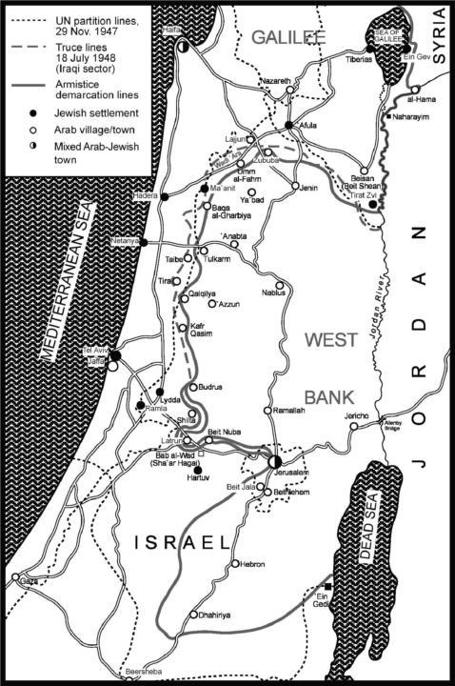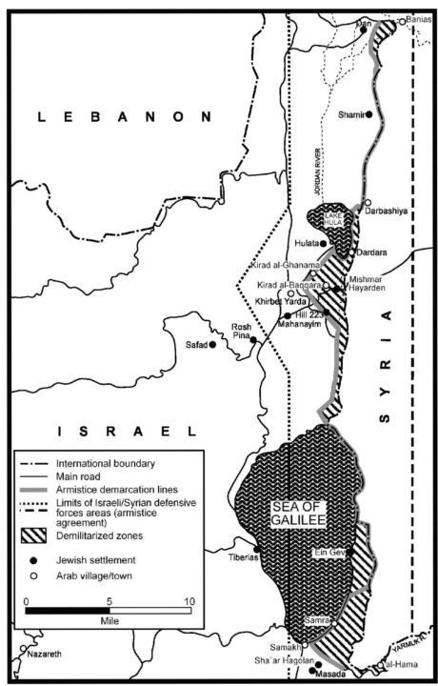Read 1948: A History of the First Arab-Israeli War Online
Authors: Benny Morris
1948: A History of the First Arab-Israeli War (74 page)

BOOK: 1948: A History of the First Arab-Israeli War
2.01Mb size Format: txt, pdf, ePub
ads

By courtesy of the Israel State Archives
The Israel-Jordan general armistice agreement lines, 3 April 194-9
The Syrians held out until last in agreeing to armistice talks-as if to underline their greater reluctance to take steps that might be construed as a willingness to acquiesce in Israel's existence (though in the course of the talks Colonel Fozi Selo, head of the Syrian delegation, said that although it was now "aiming at a temporary solution," Damascus looked forward to "advancing towards final peace").38 And the Syrian-Israeli armistice negotiations were to be the most protracted, unfriendly, and difficult.
They began on S April near Khirbet Yarda, in no-man's-land on the western edge of the Syrian-held enclave at Mishmar Hayarden. Vigier mediated but on matters of substance (and often also in matters of minute detail) was guided from New York by Bunche. The Israeli delegation was led by Maldeff, who was assisted by IDF officers and Foreign Ministry officials. Selo was flanked by army officers and a legal adviser. The lack of Syrian Foreign Ministry personnel underscored the nonpolitical, strictly military nature of the deliberations in Syrian eyes.
Israel, having neutralized the other belligerents with armistice agreements, had the advantage of facing an isolated and weaker interlocutor. But the Syrians were in possession of Israeli territory, after repeated IDF failures to dislodge them. The fact that a new Syrian regime, under Colonel Hosni Za'im, had taken power, by coup d'etat, immediately before the talks began, complicated the negotiation to the extent that the new ruler had to establish his credentials as a steadfast opponent of Zionism.
Israel demanded that the Syrians withdraw back to the old international Syria-Palestine frontier delineated by the British and French in 1923 and reaffirmed in the 1947 partition resolution39-that is, pull back from the Mishmar Hayarden enclave; the Tel al-Qasir strip southeast of the Sea of Galilee; a small strip of land between Kibbutz Dan and the village of Banias, at the northern edge of the Galilee Panhandle; and to a line a hundred yards east of the Jordan River and ten yards east of the northeastern Sea of Galilee shoreline-and constitute it as the armistice demarcation line. The Israelis relied on the just-set Lebanese precedent .4() The Syrians at first demanded that Israel withdraw from the areas in the Galilee that it had occupied in Operation Hiram. Then-echoing the Israeli stance in the talks with Egypt and Jordan-Syria argued that the armistice boundaries should mirror the existing military-territorial status quo; Damascus sought to hold onto its conquests.
The Syrians wanted first to sign a general cease-fire agreement. The Israelis demurred, arguing that such an agreement would tie their hands in the armistice negotiations, when the threat of military action might prove necessary to eke out Syrian concessions. "The Syrians are not like the other Arab peoples and we cannot rely on [that is, trust] them, and we suspect that if we sign a cease-fire, they will withdraw from all future negotiations."' I In the end, the two sides exchanged letters committing themselves to abide by previous UN resolutions.
The talks dragged on without result for more than a month. The IDF prepared for a renewal of hostilities (the plan, Operation Pine Tree, called for conquest of the Golan Heights, including Quneitra, threatening Damascus, and attacking the Mishmar Hayarden enclave from the rear).42 But BenGurion hesitated, for internal and diplomatic reasons. Bunche proposed a way out-again, by suggesting full withdrawal in exchange for demilitarization of the areas evacuated .4s The Syrians countered by proposing to bypass the armistice with a full-fledged peace agreement, which would leave the Syrians in possession of half the Jordan River (the line running down its middle from north to south) and half the Sea of Galilee, along with the (Israeli) strip of territory along its eastern shoreline around `Ein-Gev. Za`inm proposed a face-to-face meeting with Ben-Gurion and expressed a willingness to absorb three hundred thousand Palestinian refugees within the context of a peace treaty.44 Ben-Gurion refused to meet.45 He regarded Za`im's proposals as most likely insincere and, at best, as designed to leave Syria in possession of Israeli territory and vital water resources. He demanded that the Syrians first agree to withdraw back to the international line; afterward, the two sides could negotiate "peace."
Haggling over the exact constitution of the DMZs followed, with Bunche proposing that these be expanded to include the Israeli-held eastern shoreline of the lake.46 Israel agreed. The Syrians regarded the DMZs as areas in which neither country was to be sovereign; the Israelis, as Israeli territory from which the military were to be barred. The disagreement on this issue remained unresolved. The two sides agreed on limitation of forces zones along each side of the border. The two states signed the armistice agreement, to be supervised by a MAC, on 20 July.47

By courtesy of the Israel State Archives
Israel-Syria general armistice agreement lines, 20 July 1949
The Syrians withdrew back to the international frontier and the areas evacuated became DMZs. Local Jewish police administered the Jewish-inhabited areas (Mishmar Hayarden, `Ein-Gev), and local Arab policemen the Arab-inhabited areas (Kirad al-Baqqara).
The signing of the general armistice agreements marked the formal end of the first Arab-Israeli war. The state ofwar had been replaced by a de jure state of nonbelligerency. Subsequently, the international community and, to a somewhat lesser degree, the former combatants themselves, were to recognize the armistice lines as de facto international frontiers. The agreements also provided for the establishment of four separate UN-chaired MACs to supervise the implementation of the agreements and to adjudicate in disputes relating to their provisions.
The armistice agreements were not peace treaties and did not provide for many of the features that normally govern the relations between neighboring states at peace with each other (diplomatic relations, trade ties, and so on). During the following years, Arab leaders made abundantly clear their uniform view that the armistice accords were merely elaborate cease-fire agreements, implicitly temporary and qualitatively different from and well short of full peace treaties.
In Israel, a more complex appreciation of the agreements took hold, with some leaders, including Ben-Gurion, viewing them as de facto peace accords, which effectively freed them from the need energetically to pursue full peace, while others took the Arab view that they were overblown cease-fire agreements that would have to be overtaken by peace treaties-or else they might issue in renewed fighting once one or both sides felt it to be in their interest. This, in fact, is what happened along both the Israeli-Syrian and IsraeliEgyptian frontiers as the three countries fought over control of the DMZs, a struggle that was one of the precipitants to the 1956 Suez-Sinai War between Egypt and Israel (and Britain and France) and between the Israelis and the Syrians in 1967.
Nonetheless, down to 1967 the armistice accords in large measure governed Israeli-Arab border relations, both through what they lacked and through what they stipulated.




"The Palestine problem is still in its infancy. The preface ended with the [end of the] Mandate and Chapter One began [in November 1947].... Do not miss [the `next installment']!" recommended the British consul general in Jerusalem midway through the 1948 War.'
"Chapter One," the first war between Israel and the Arabs, was the culmination of developments and a conflict that had begun in the 188os, when the first Zionist settlers landed on the shores of the Holy Land, their arrival and burgeoning presence increasingly resented by the local Arab population. Over the following decades, the Arabs continuously inveighed, first with the Ottoman rulers, and then with their British successors, against the Zionist influx and ambitions, and they repeatedly attacked the new settlers, initially in individual acts of banditry and terrorism and then in growingly massive outbreaks, which at first resembled nothing more than European pogroms.
The Zionists saw their enterprise and aspirations as legitimate, indeed, as supremely moral: the Jewish people, oppressed and murdered in Christendom and in the Islamic lands, was bent on saving itself by returning to its ancient land and there reestablishing its self-determination and sovereignty. But the Arab inhabitants, supported by the surrounding, awakening Arab world, decried the influx as an aggressive invasion by colonialist, infidel aliens; it had to be resisted. The culminating assault on the Yishuv in 19471949 was a natural result of this posture of antagonism and resistance.

BOOK: 1948: A History of the First Arab-Israeli War
2.01Mb size Format: txt, pdf, ePub
ads
Other books
Rain Village by Carolyn Turgeon
Reaping The Harvest (Harvest Trilogy, Book 3) by Michael R. Hicks
Death in a Summer Colony by Aaron Stander
Quest Maker by Laurie McKay
Covenant of War by Cliff Graham
Eliza's Child by Maggie Hope
Everything Here Is the Best Thing Ever by Justin Taylor
Eloisa James by With This Kiss
Dark Passions by Jeff Gelb
